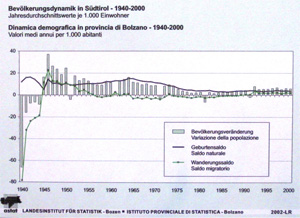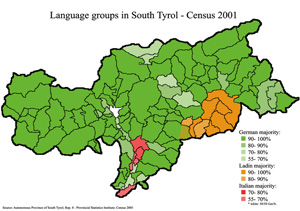4. South Tyrol after 1945
4a. Graphic: Population Movement in South Tyrol / Alto Adige after 1940
 Click image to enlarge
Click image to enlarge
4b. Map: The dominant language groups in South Tyrolean municipalities today
Terms from the graph:
Geburtensaldo:
The Geburtenbilanz (Birth Balance) or Geburtensaldo (Natural Population Development) is the number of live births minus the number of deaths in a given area over a specified period of time
Wanderungssaldo:
The term Wanderungsbilanz (Migration Balance) or Wanderungssaldo is one of the measures of demography and is the difference between the number of immigrants entering a country and the number of emigrants leaving a country in a given area over a specified period of time
Hopes for reunification of the two parts of Tyrol were not fulfilled. The Gruber – De Gasperi Agreement (Paris Agreement) of 1946 saw the Italian state grant autonomy to South Tyroleans. However, the implementation of this agreement took an extremely long time. In the 1960s there were a number of bomb attacks out of frustration at Italy’s policies in South Tyrol.
Since 1992 the level of self-government that was envisaged in the original Agreement has been operating after an agreement on key points in the legislation.
Thanks to the European Union, the Schengen Area and the establishment of the Euroregion of Tyrol – South Tyrol – Trentino, political borders between the areas of historical Tyrol are disappearing more and more.
 Click image to enlarge
Click image to enlarge
Questions
Description and Analysis
For a short time after the Second World War, South Tyroleans hoped for a reunification with the North Tyrol in the revived Republic of Austria.
However, as the Allied Powers of France, USA, Great Britain and Russia exercised de jure government power, Austria was in a clearly inferior political position for its negotiations with Italy, which were also connected to the Allies. Austria was unable to convince the Allied Powers of the population’s democratic right to reunification. This is how South Tyrol remained a part of Italy.
Under the Paris Agreement – also known as the Gruber-De-Gasperi Agreement – South Tyroleans were only granted autonomous rights in the region of South Tyrol – Trentino; Austria was recognised as its protective power.
However, in Italy the implementation of the key points of the Paris Agreement was delayed, which lead to a gradual South Tyrolean resistance against the first Statute of Autonomy. Between 1956 and 1969, frustration at Italy’s policies in South Tyrol led to a series of bomb attacks. The first series of attacks up to 1961 were organised by the South Tyrolean Liberation Committee (Befreiungsausschuss Südtirol), but not directed at people. However, the second wave of attacks between 1961 and 1969 were much more violent and bloody, killing several people.
South Tyrol today
Due to the special protection measures for the German-speaking and Ladin-speaking populations, South Tyrol is a model region for the autonomy of ethnic minorities. Despite a very conflicting past, all sections of the population have managed to co-exist peacefully.
Despite that, there is still not the desired level of real interaction. The separate ways of life of each section of the population are mainly strengthened by the school system, but also by the concentration of Italians in the bigger cities and towns. The fact that the Italian-speaking portion of South Tyrol / Alto Adige have origins from all over Italy has impaired the formation of a strong common identity. Furthermore, Italian-speaking South Tyroleans have a very poor command of the German language (not to mention the South Tyrolean dialect). Since the introduction of proportional representation, even the public service is no longer a purely Italian domain. Certain tensions between the population groups, otherwise known as language groups, have remained as a result.
Language Distribution in South Tyrol
| Language | 1991 | 2001 |
|---|---|---|
| German | 67,99 % | 69,15 % |
| Italian | 27,65 % | 26,47 % |
| Ladin | 4,36 % | 4,37 % |
http://www.provincia.bz.it/ASTAT/downloads/mit17_02.pdf
Answers to the Questions
- From the population dynamics graph:
In the first 5 years after the Second World War, the annual immigration figures (net migration) were between 16,000 and 22,000 - Out of frustration at Italy’s policies in South Tyrol, in the 1960s there were:
Bomb attacks in South Tyrol - From the map:
In the majority of South Tyrolean municipalities there is mainly a German-speaking population




The return of the “optants”: In 1947, 49,000 of the original 75,000 South Tyroleans who had left their homeland were still living in Austria. In total, almost 70% of the “Reich’s Optants” returned to their homeland (the so-called return settlers).